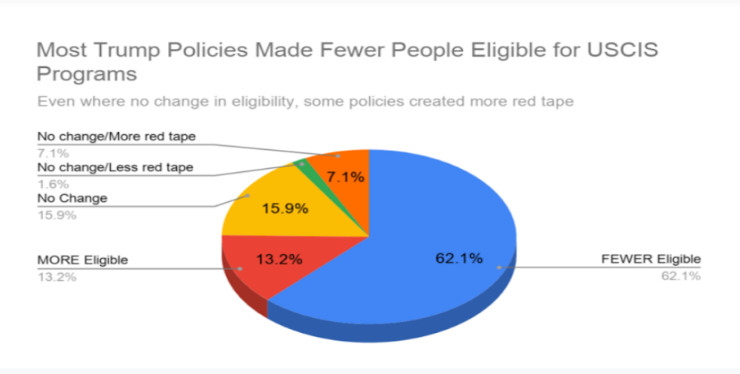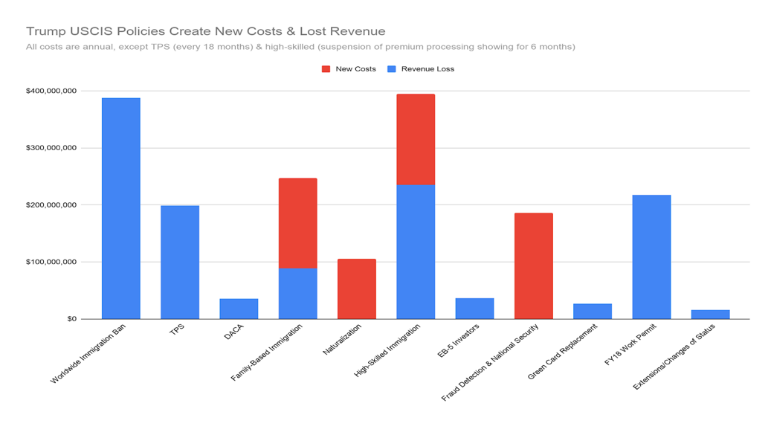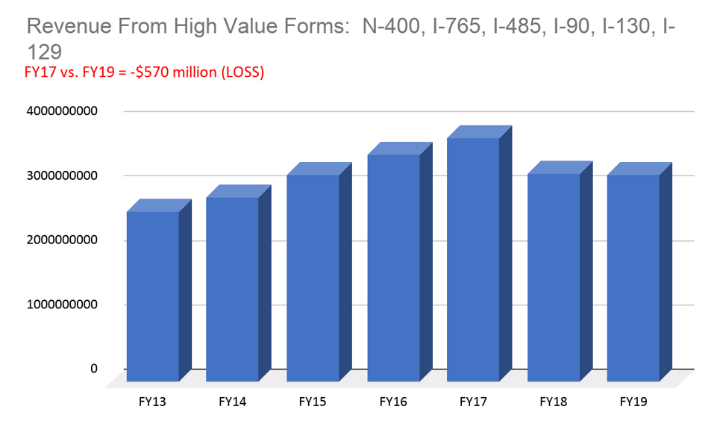From Day One, the Trump Administration has led a failed immigration strategy driven by their deeply held xenophobic ideology and cynical political ambitions, not guided by the best interests of Americans, our families or our economy. The result — a financial crisis at USCIS that will harm thousands of federal workers in the middle of a pandemic. Yesterday, Government Executive reported that USCIS is about furlough up to 15,000 USCIS employees. The Trump administration claims the agency is broke because the pandemic has led to fewer applications, starving the fee-funded agency. Nothing could be further from the truth. As Catherine Rampell of the Washington Post noted yesterday, “The agency claims it’s a novel coronavirus victim. No doubt, the covid-19 pandemic has disrupted operations. But USCIS was in financial trouble long before the virus’s outbreak.” The reason: over 100 xenophobic immigration policies under the Trump administration over the last three and half years.
We know this because pre-pandemic, in November 2019, the Trump administration issued a proposal for public notice and comment to significantly increase USCIS processing fees based upon a projected annual deficit of $1.2 billion and a negative carryover balance of $1.5 billion in fiscal year 2020. Just a couple years ago, USCIS projected a positive carryover balance of $800 million, according to the fee rule.
We also know this because a DHS Watch review of the Immigration Policy Tracking Project revealed a web of 182 actions — an unprecedented number — that:
- Made more people ineligible to apply;
- Made it more difficult to apply and be granted a benefit; and,
- Introduced a web of “extreme vetting” with little to no justification other than to slow things down.
The result — significant losses in revenue due to fewer applications and increased costs, such as more staff, to implement time-consuming adjudication changes grounded in xenophobia.
Results of Review of 182 Trump Administration Immigration Policies Affecting USCIS – fewer eligible to apply, more red tape, less revenue, more costs
Key Impact Areas
While some policies and actions had more significant negative effects on the financial solvency of USCIS, there aren’t two or three that represent the bulk of the problem. Instead, it is the combination of many actions — an unprecedented 182 in just a little over three years — most of which have led to this situation. However, there are some key areas where Trump Administration changes in immigration and naturalization caused the greatest impact in lost revenue and increased costs.
Case Example: Naturalization
While the number of naturalization applications did not decrease outside of historical norms, except for military naturalizations (68% drop in applications), our review found almost 20 different policies related to naturalization since January 2017, most of which created more red tape and extreme vetting, costing the agency much more in resources to adjudicate forms. As a result, model output (i.e. USCIS calculation of cost to adjudicate a specific form) for most forms related to naturalization increased, resulting in additional cost of $105 million.
Case Example: DACA
With a stroke of a pen on September 5, 2017, the Trump administration ended DACA. While courts have ordered DACA renewals to continue, the initial applicant program remains terminated. This represents lost revenue of $36 million based upon FY16 data.
Case Example: TPS
By mid-2018, the Trump administration had ended six TPS programs, terminating TPS for 402,195 individuals, or 98% of all current TPS recipients. TPS termination is on hold because of court order. However, the regular process for renewing TPS status — generally every 18 months, generating $199 million in application fee revenue, has now been replaced with automatic free-of-charge renewals by Federal Register.
Case Example: Family-Based Immigration
In family-based immigration, multiple forms have been affected. The cost to adjudicate several family-based immigration forms increased by a total of $158 million. The number of family-based petitions also decreased, thereby reducing desperately needed money for the agency by $89 million.
Case Example: High-Skilled Immigration
Like family-based immigration, high-skilled immigration also experienced lost revenue and cost increases. The annual costs to adjudicate key high-skilled immigration forms increased by $159 million and $235 million of annual revenue has been lost.
Key Forms
Historically, the forms that generated the highest receipt volumes and associated revenue are:
- N-400: Application for Naturalization
- I-765: Employment Authorization
- I-485: Adjustment of Status (“Green Card”)
- I-90: Replacement of Permanent Resident Card
- I-130: Petition for Alien Relative
- I-129: Petition for Nonimmigrant Worker
All, except the I-129, showed decreases in volume since Trump took office. Yes, not all saw huge decreases, but even a small decrease means millions for the agency AND combined, it is detrimental to the agency’s bottom line — almost $600 million annually.
Ur Jaddou, Director of DHS Watch and former USCIS Chief Counsel, said:
This administration is so singularly focused on locking immigrants out from legal immigration and naturalization that they will do anything to accomplish this xenophobic policy, even at the risk of furloughing 15,000 federal workers in the middle of a pandemic. No, this is not the pandemic’s doing. Instead, these furloughs are the direct result of three and half years of resolute opposition to legal immigration, which increased costs and drove down revenue, leaving the agency in financial crisis. And now the Trump administration is holding Congress hostage, threatening to furlough 15,000 federal workers if they don’t save the agency from a financial crisis of their own making. The impact will be felt most severely in Texas, Vermont, Nebraska, California and Missouri where large USCIS processing centers are located and the furloughs will hit the local economy directly. Worse yet, just as they are holding Congress hostage with one hand, they are about to use the other hand to do much more of the bank-breaking policies to slow or stop legal immigration that got them into this mess, all in front of Congress’ view.
Nonetheless, Congress should rescue the agency from the Trump administration and avoid furloughs of federal workers in a pandemic. This means providing USCIS the funding it needs to avoid furloughs, reversing the actions that got them here in the first place, preventing more of it in the future, and ALSO ensuring that the rescue money — American tax dollars — is spent in ways that reflect the values of the nation, not the xenophobic views of Stephen Miller, President Trump and the rest of the administration that have locked people out of the immigration system based upon wealth, race, over-zealous enforcement, and bureaucratic red tape.
David Leopold, Counsel to DHS Watch, Chair of Immigration at Ulmer & Berne and former President of the American Immigration Lawyers Association, said:
This is not about an underfunded immigration agency forced to lay off federal workers. This is about the Trump administration intentionally starving USCIS of operating revenue in an effort to choke off legal immigration without Congress changing a word of the law. Most insidiously, the Trump administration is stopping legal immigration by intentionally creating a situation where USCIS receives fewer fee-based immigration benefit applications and is burdened with increased costs and time-consuming adjudication changes. The Trump Administration does not have the guts to take its anti-immigrant extremism to Congress because it knows full well its nativist policies will be soundly rejected. Instead, the Trump administration has implemented xenophobic immigration policies which have starved the USCIS of operating revenue and led to the current plan to furlough 15,000 federal workers, further crippling the legal immigration process.






